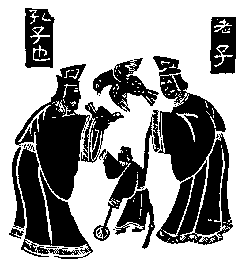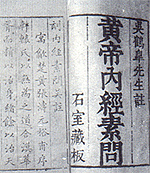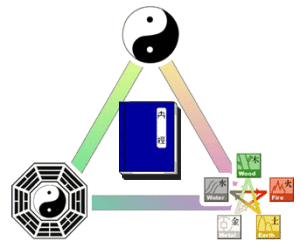The Zhou Dynasty approx. 1100 ∼ 221 BC
This dynasty is divided into four periods:
- Western Zhou 1100 ∼771 BC
- Eastern Zhou 700∼256 BC
- Spring and Autumn Period 770 ∼476 BC
- Warring States Period 476∼221 BC
Western Zhou (1100∼771 BC)
The Western Zhou people migrated to the Shang region in 1111 BC, initially adopting the Shang’s customs. However, over time people started to rebel

Confucius and Lao-zi
against the ancient customs and beliefs. It was an age of political and social unrest with a breakdown in the morals of the people. Feudalistic states were constantly at war with one another.
Confucianism and Taoism
Two important persons emerged from this period. One was Confucius (557-479 BC). Confucius was a social reformist and a teacher.
He wanted to restore order in this time of chaos. His contemporary, Lao-zi (born in 590 BC), was the founder of Taoism. Taoism teachings were more philosophical whereas Confucianism teachings were more practical. Even today their philosophies are still important in the Chinese culture, and have helped shape the practice of Chinese medicine.
Eastern Zhou (700∼256 BC)
An organized medical system developed during this period.
Court Physicians
According to the book Rites of Zhou which recorded the ceremonies or systems for that time, the Eastern Zhou period had an organized medical system in which court officials of the emperor were trained in a variety of medical specialties. For example, jiyi were physicians who cured internal illnesses, yangyi were physicians who cured external illnesses such as wounds, skin problems, broken bones and other traumatic injuries, and shiyi were physicians who dealt with dietary problems. The first official Chinese veterinarians also appeared during this time.
Spring/Autumn Period (770 ∼476 BC)
A number of physicians contributed a great deal of knowledge to TCM in this period. One notable physician was Bian Que. Bian Que’s skills were based on the four fundamental examination procedures of Chinese medicine. He would observe his patient’s tongue, nose, ears, face, eyes, mouth and throat, listen to his patient’s speech, coughing, or other bodily vibrations, take a complete history of the patient’s problem, and lastly he would feel the patient’s pulse. Bian Que also believed illness was caused by the imbalance of yin and yang. Using these examination techniques, Bian Que was an expert in many fields of medicine including gynecology, pediatrics, ophthalmology, psychiatry and otorhinolaryngology (ENT).
Warring States Period (476∼221 BC)
During the Warring States Period, China’s feudalistic government split into seven different states. It was around this time period that the yin/yang philosophy and the use of five elements to describe causes for illness, were further developed and their uses began to be taught in schools and written about in books.
The Yellow Emperor’s Classic of Internal Medicine (huang di nei jing)

The Yellow Emperor’s Classic of Internal Medicine (huang di nei jing)
Although the book’s authorship is attributed to the Yellow Emperor, it was actually written by several authors over a long period of time. This book is further divided into two sections. The first is the Plain Questions (su wen) that was written in the Warring States periods. The second part is called the The Vital Axis (ling shu) and was written sometime in the second century BC with revisions taking place up to the Han Dynasty (206BC ∼ 25 AD). This book is very significant because it was one of the earliest concise medical writings about Chinese medicine. Beyond medicine, this book also presents ethical, philosophical and religious considerations. The three themes that run through the book are the theory of Taoism, yin and yang, and the five elements.

Themes in the Classic of Internal Medicine (nei jing)
In 1973 and 1974, excavation of the Mawangdui tombs revealed medical writing dating back to 168 BC One text called the Fifty-two Prescriptions (wu shi er bing fang), detailed 52 ailments and 52 prescriptions, and was the earliest written reference of Chinese pharmacology. Despite the fact that many writings are the earliest known Chinese medical references, the Yellow Emperor’s Classic of Internal Medicine still remains as one of the most respected and studied texts on Chinese medicine. Even today scholars on Chinese medicine still refer to the wealth of knowledge in this book.
| Shang :Previous | Index | Next: Qin & Han |



